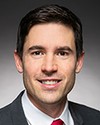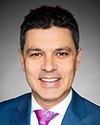Thank you very much, Mr. Arnold.
With that, we'll move to our second questioner in the third round.
Mr. Cormier, you have the floor for five minutes.
Evidence of meeting #4 for Fisheries and Oceans in the 45th Parliament, 1st session. (The original version is on Parliament’s site, as are the minutes.) The winning word was redfish.
A recording is available from Parliament.
September 25th, 2025 / 9:20 a.m.
Liberal

The Chair Liberal Patrick Weiler
Thank you very much, Mr. Arnold.
With that, we'll move to our second questioner in the third round.
Mr. Cormier, you have the floor for five minutes.
Liberal

Serge Cormier Liberal Acadie—Bathurst, NB
Thank you, Mr. Chair.
I just want to come back to my previous question for Mr. Williams.
Mr. Williams, what I was saying is that, in the redistribution of the quota, offshore gets 60% of this new redfish quota. I'm not sure if you're aware of this, but in the 1970s, former minister of fisheries Roméo LeBlanc imposed a kind of a fishing ban in the Gulf of St. Lawrence for vessels over 100 feet. He did that because he was, at that time, very concerned about the decline of the redfish. He imposed a restriction on boats of over 100 feet coming to fish redfish in the Gulf of St. Lawrence.
Were you aware that the former minister of fisheries did that in, I think, 1976 or 1977 or whenever—some time around then?
Senior Director, Fisheries Resource Management Operations, Department of Fisheries and Oceans
I'm aware of the statement. However, we've been unable to uncover any type of concrete evidence that this policy remains.
Senior Director, Fisheries Resource Management Operations, Department of Fisheries and Oceans
It was at least a statement by the minister, yes.
Liberal

Serge Cormier Liberal Acadie—Bathurst, NB
We're now saying in 2025—actually, DFO is saying—that we want to have a more sustainable fishery. We want to protect the resources. We want to make sure that fleets and fishermen can live through the fisheries. We're making sure that at-sea agents are also taken care of.
In that case, where in the Gulf of St. Lawrence is the 60% offshore quota that was given coming from? What are those companies? Who are they?
Senior Director, Fisheries Resource Management Operations, Department of Fisheries and Oceans
I should add as well that these vessels are based in Atlantic Canada. They are Atlantic Canadian companies with Canadian crews, with landings at Canadian ports and processing plants. There are nine licence-holders—
Liberal

Serge Cormier Liberal Acadie—Bathurst, NB
What are one or two names of the big companies that own these big offshore boats?
Senior Director, Fisheries Resource Management Operations, Department of Fisheries and Oceans
Mersey would be one.
Senior Director, Fisheries Resource Management Operations, Department of Fisheries and Oceans
Yes.
Senior Director, Fisheries Resource Management Operations, Department of Fisheries and Oceans
In Nova Scotia.
Liberal

Serge Cormier Liberal Acadie—Bathurst, NB
Okay.
Mersey Seafoods, for example, didn't have any redfish quota for the past 30 years, because the fishery was closed, right?
Senior Director, Fisheries Resource Management Operations, Department of Fisheries and Oceans
They would have had the licence for groundfish in the gulf, which would have included redfish had it opened, but they weren't accessing it at the time.
Liberal

Serge Cormier Liberal Acadie—Bathurst, NB
Okay.
I think we can all agree around this table that Mersey Seafoods do very well, even if they've had no redfish quota for the past 30 years, right?
Senior Director, Fisheries Resource Management Operations, Department of Fisheries and Oceans
I'm not going to speak to the economic viability of a private enterprise.
Liberal

Serge Cormier Liberal Acadie—Bathurst, NB
Okay. Perfect.
Look, I guess my point is this. You're saying that we develop a new redfish fishery. Instead of going with the historical share, we went on and did another new fishery with new entrants. We gave quota, for example, to first nations as well as to shrimp fishers, who were a bit more in trouble and needed some quota through redfish.
How can we make sure that no boat over 100 feet is coming into the Gulf of St. Lawrence to fish redfish? What will be the mechanism? What will be the process to not have those big boats come into the Gulf of St. Lawrence to have a hard impact on the resources again, just like they had before the fishery was closed?
Senior Director, Fisheries Resource Management Operations, Department of Fisheries and Oceans
I think for those licence-holders—Belle Baie, Madelipeche, Mersey and others—the key here is with respect to fisheries management measures. The fact that they have 100% at-sea observer coverage and the fact that we have certain area closures and depth restrictions are key in having a well-managed fishery. This type of fishery operates on very thin margins. We need a wide range of stakeholders and harvesters to develop those markets. We think there's value in that.
Liberal

Serge Cormier Liberal Acadie—Bathurst, NB
Okay, but don't you think, Mr. Williams, that if five or six or eight big boats over 100 feet—we're talking about big boats when we're talking about boats like that—come into the Gulf of St. Lawrence, do one or two passes and cut the quota, there will be nothing left for other small fleets, such as shrimp, for example?
I'm going to be honest: I was happy that at least the shrimp fishers got 10%, because it was a start, but don't you think that having big boats in the Gulf of St. Lawrence again will put redfish resources in a difficult spot again, if you let that happen?
Senior Director, Fisheries Resource Management Operations, Department of Fisheries and Oceans
Thanks very much.
Again, we have fisheries management measures in place. We have the science to back up the total allowable catch. The fact is that so far this year and last, the under-65 fleet has done a considerable number of those landings.
Liberal

The Chair Liberal Patrick Weiler
Thank you, Mr. Cormier.
Mr. Deschênes has the floor for two and a half minutes.
Bloc

Alexis Deschênes Bloc Gaspésie—Les Îles-de-la-Madeleine—Listuguj, QC
Thank you, Mr. Chair.
I have some more questions, this time concerning the indigenous aspect. Exploratory licences have been issued in three zones. In zone 17, or the Anticosti zone, the total number of traps authorized is 4,500. Of this number, 2,250 are allocated to indigenous people.
In zone 19, 52 licences were issued. However, the number of traps isn't the same. Just in terms of traps in this zone, 7,750 traps were authorized for exploratory licences. Of this amount, 4,250 traps, accounting for 55% of the total number of exploratory licences, were allocated to indigenous people, and 3,500 traps were allocated in phases to other fishers.
Ms. Lemire, I don't have the figures for zone 18. For the Côte‑Nord region, we can see that the equivalent of 25 licences were issued. Of that number, how many were allocated to the first nations?
Fisheries Management and Aquaculture Regional Director, Quebec Region, Department of Fisheries and Oceans
I'll have to get back to you on this, since I don't have that specific information on hand.